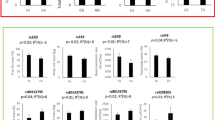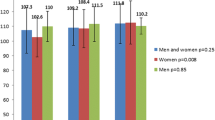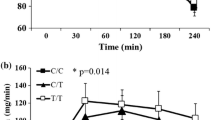Abstract
Obesity is under the influence of genetic and nutritional factors. The objective was to verify whether variants in the gene encoding the carnitine palmitoyltransferase I (CPT1), a key enzyme in β-oxidation of fatty acids, are associated with obesity phenotypes, alone or in interaction with fat intake. Sequencing of CPT1 was performed in 40 overweight subjects and 4 controls. Genotypes were determined in 351 French-Canadians. Fat intake was evaluated by a food frequency questionnaire. We identified 14 genetic variations in CPT1A and 26 in CPT1B. Nine variants within CPT1B and one variant within CPT1A were selected for further analyses based on the minor allele frequency (>10%) or on potential functional impact. A significant association between obesity phenotypes (BMI, weight, and waist girth) and CPT1B c.282-18C > T and p.E531K variants was observed (p < 0.05) No other association was found with variants in CPT1A and CPT1B. When subjects were divided into six groups according to p.E531K genotypes and further on the basis of fat using the median value as a cutoff point (34.4% of energy), BMI, weight, and waist girth were higher in E531/K531 on a high-fat diet compared to E531/K531 subjects under a low-fat diet (p = 0.004, p = 0.006, p = 0.003, respectively). There was no difference among E531/E531 and K531/K531. Similar results were obtained with the CPT1A p.A275T variant as BMI and waist girth were higher in A275/A275 on a high fat compared to A275/A275 subjects on a low-fat diet. Among carriers of the T275 allele, obesity indices were not affected by fat intake (p = 0.05 and p = 0.008 for BMI and waist girth, respectively). Among variants within the CPT1B gene, 13 haplotypes were inferred and the two most frequent haplotypes, H7 (38.0%) and H5 (27.7%), were kept for diplotype analysis. These haplotypes were not associated with indices of obesity, but as observed with the CPT1B E531K variant fat intake modulated this association. In conclusion, this finding suggests that indices of obesity might be modulated by an interaction between CPT1 variants and fat intake.



Similar content being viewed by others
References
Morrill AC, Chinn CD (2004) The obesity epidemic in the United States. J Public Health Policy 25:353–366
Haslam DW, James WP (2005) Obesity. Lancet 366:1197–1209
Perusse L, Bouchard C (2000) Gene–diet interactions in obesity. Am J Clin Nutr 72:1285S–1290S
Bray GA, Champagne CM (2005) Beyond energy balance: there is more to obesity than kilocalories. J Am Diet Assoc 105:S17–S23
McGarry JD (1995) The mitochondrial carnitine palmitoyltransferase system: its broadening role in fuel homoeostasis and new insights into its molecular features. Biochem Soc Trans 23:321–324
Yamazaki N, Yamanaka Y, Hashimoto Y, Shinohara Y, Shima A, Terada H (1997) Structural features of the gene encoding human muscle type carnitine palmitoyltransferase I. FEBS Lett 409:401–406
Perusse L, Rankinen T, Zuberi A, Chagnon YC, Weisnagel SJ, Argyropoulos G, Walts B, Snyder EE, Bouchard C (2005) The human obesity gene map: the 2004 update. Obes Res 13:381–490
World health Organization (1985) Diabetes mellitus: report of a WHO study group. World Health Org. Tech. Rep. Ser., no.727. Geneva, Switzerland
(1988) Standardization of anthropometric measurements. In: Lohman T, Roche A, Martorel R (eds) The Airlie (VA) Consensus Conference. Human Kinetics Publishers, pp 39–80
Abecasis GR, Noguchi E, Heinzmann A, Traherne JA, Bhattacharyya S, Leaves NI, Anderson GG, Zhang Y, Lench NJ, Carey A, Cardon LR, Moffatt MF, Cookson WO (2001) Extent and distribution of linkage disequilibrium in three genomic regions. Am J Hum Genet 68:191–197
Stephens M, Smith NJ, Donnelly P (2001) A new statistical method for haplotype reconstruction from population data. Am J Hum Genet 68:978–989
Zurlo F, Lillioja S, Esposito-Del Puente A, Nyomba BL, Raz I, Saad MF, Swinburn BA, Knowler WC, Bogardus C, Ravussin E (1990) Low ratio of fat to carbohydrate oxidation as predictor of weight gain: study of 24-h RQ. Am J Physiol 259:E650–E657
Simoneau JA, Veerkamp JH, Turcotte LP, Kelley DE (1999) Markers of capacity to utilize fatty acids in human skeletal muscle: relation to insulin resistance and obesity and effects of weight loss. FASEB J 13:2051–2060
Wang YX, Lee CH, Tiep S, Yu RT, Ham J, Kang H, Evans RM (2003) Peroxisome-proliferator-activated receptor delta activates fat metabolism to prevent obesity. Cell 113:159–170
Comings DE, MacMurray JP (2000) Molecular heterosis: a review. Mol Genet Metab 71:19–31
Stenbit AE, Tsao TS, Li J, Burcelin R, Geenen DL, Factor SM, Houseknecht K, Katz EB, Charron MJ (1997) GLUT4 heterozygous knockout mice develop muscle insulin resistance and diabetes. Nat Med 3:1096–1101
Brown NF, Mullur RS, Subramanian I, Esser V, Bennett MJ, Saudubray JM, Feigenbaum AS, Kobari JA, Macleod PM, McGarry JD, Cohen JC (2001) Molecular characterization of L-CPT I deficiency in six patients: insights into function of the native enzyme. J Lipid Res 42:1134–1142
Ordovas JM, Corella D (2004) Nutritional genomics. Annu Rev Genomics Hum Genet 5:71–118
Block G, Woods M, Potosky A, Clifford C (1990) Validation of a self-administered diet history questionnaire using multiple diet records. J Clin Epidemiol 43:1327–1335
Willett WC, Reynolds RD, Cottrell-Hoehner S, Sampson L, Browne ML (1987) Validation of a semi-quantitative food frequency questionnaire: comparison with a 1-year diet record. J Am Diet Assoc 87:43–47
Santé Québec, Bertrand L (1995) Les Québécoises et les Québécois mangent-ils mieux? Rapport de l’enquête québécoise sur la nutrition, 1990. Montréal
Heart and Stroke Foundation of Canada (1999) The Changing Face of Heart Disease and Stroke in Canada 2000.http://www.cvdinfobase.ca/cvdbook/En/Index.htm
Després JP (1998) The insulin resistance-dyslipidemic syndrome of visceral obesity: effect on patients’ risk. Obes Res 6(1):8S–17S
Lemieux S, Prud’homme D, Bouchard C, Tremblay A, Després JP (1996) A single threshold value of waist girth identifies normal-weight and overweight subjects with excess visceral adipose tissue. Am J Clin Nutr 64:685–693
Acknowledgements
The authors would like to acknowledge the contribution of the staffs of the CHUL Lipid Research Center and the Lipid Clinic, as well as the Department of Biochemistry and the Cardiology Service of the Chicoutimi Hospital for their dedicated support and assistance. The authors would like to express their gratitude to the subjects for their excellent collaboration.
This study was supported by a grant from the Canadian Institutes of Health Research (MOP-44074) and the Heart and Stroke Foundation of Canada. J. Robitaille received a doctoral studentship from the Canadian Institutes of Health Research. M.C. Vohl and S. Lemieux are research scholars from the “Fonds de la recherche en santé du Québec (FRSQ).” D. Gaudet is the chairholder of the Canada Research Chair in preventive genetics and community genomics (http://www.chaires.gc.ca).
Author information
Authors and Affiliations
Corresponding author
Electonic supplementary materials.
Below is the link to the electronic supplementary material.
Rights and permissions
About this article
Cite this article
Robitaille, J., Houde, A., Lemieux, S. et al. Variants within the muscle and liver isoforms of the carnitine palmitoyltransferase I (CPT1) gene interact with fat intake to modulate indices of obesity in French-Canadians. J Mol Med 85, 129–137 (2007). https://doi.org/10.1007/s00109-006-0116-7
Received:
Revised:
Accepted:
Published:
Issue Date:
DOI: https://doi.org/10.1007/s00109-006-0116-7




